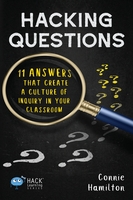Spin the Throttle: How to Teach the Art of Inquiry
Apr 04, 2025
THE PROBLEM: TEACHERS ASK ALL THE QUESTIONS
We place a heavy emphasis on teachers crafting and delivering high-quality questions. But when the teacher is the only one asking, we’re withholding ownership of the learning from students. We can’t fully transfer the drive for learning to students if we control all the questions.
Businesses value employees who ask questions that lead to improvement. Social media frequently celebrates the value of asking the right question over simply knowing an answer. State standards require schools to teach students how to ask and answer questions with depth and purpose.
Yet the number of academic questions students generate remains a fraction of those asked by teachers. And most student questions are basic clarifications rather than interpretive or analytical.
When students do ask questions, they’re often either absurdly broad or overly narrow. A vague peer-to-peer question like, “What do you think?” suggests little thought from the asker and invites a similarly vague response. On the other end of the spectrum, questions like “Is this one right?” or “How do you spell ____?” are hyper-specific and only relevant to that one moment.

Some teachers manage to help students ask questions that fall in the productive middle of this spectrum. The next challenge is helping students generate multiple questions and then reflect on which are most useful and why.
THE HACK: SPIN THE THROTTLE
There’s a time for teachers to lead the learning—and a time to let students lead. Questions are one of the most effective ways to engage learners, and spinning the throttle means putting students in control of their own inquiry. But we can’t just tell students to “ask better questions” and expect them to do it. Exposure alone won’t teach them to inquire like Socrates.
If we want students to become skilled questioners, we need to teach them explicitly about the art of questioning. As you implement strategies to improve your own questioning, students will start to mirror your example. To accelerate their growth, directly teach how to write, critique, and pose questions.
Two approaches have proven especially powerful: the Question Formulation Technique (QFT) from the Right Question Institute and a structure called reciprocal teaching.
QFT teaches students to generate, evaluate, and refine their own questions. The process invites students to analyze their questions before using them in investigations. When students develop their own questions through this method, they become more committed to pursuing answers.
Reciprocal teaching is a collaborative strategy that assigns roles to students as they read a text:
-
Summarizer: Pauses to recap key points for comprehension.
-
Questioner: Raises questions and observations about the text.
-
Clarifier: Identifies confusing parts and works to explain them.
-
Predictor: Anticipates what will come next based on clues and background knowledge.
These roles promote active engagement and help students build discussion and inquiry skills. Beginning in third grade, many state standards expect students to prepare for conversations by generating questions. Instead of telling students what to ask, teach them how to design and refine their own questions using these frameworks.
Start by offering sample questions that align with each role in reciprocal teaching. As students get comfortable with QFT, encourage them to replace pre-written questions with ones they generate themselves. This blend will ignite student conversations and deepen learning.
WHAT YOU CAN DO TOMORROW
Young children naturally ask questions. But school often dulls that instinct. Try these tips to bring back your students’ curiosity.
Let wonderings marinate. Not every question needs an immediate answer. If it doesn’t require urgent clarification, let it linger—maybe even for a few days. This builds mental stamina and encourages independent exploration. Today, people turn to their phones for instant answers. Help students see the value of wrestling with uncertainty and making discoveries on their own.
Launch a lesson with questions. Instead of starting with what students already know, try beginning with what they wonder. Hack the traditional KWL chart into a QKAN chart:
-
Questions: What do you want to know?
-
Knowledge: What strategies or knowledge do you already have?
-
Answers: What do you already understand?
-
Next Steps: How will you fill in the gaps or go deeper?
This primes students to be active participants and gives them ownership of their learning path.
Model your curiosity. When a question pops into your head, say it out loud. Show students that curiosity isn’t just for the classroom—it’s a way of living and thinking.
Leave some inquiries unanswered. There are two times when it’s okay to let questions hang: when answering prematurely could create misconceptions, and when answering would sidetrack the day’s goal. Place those questions in a “parking lot” and return to them later.

Image credit: Hacking Questions, by Connie Hamilton (Times 10 Publications)
Compare questions. Discuss what makes one question clearer or more powerful than another. If a question needs revision, explain why. When a student asks a strong question, name what made it strong. This helps students internalize the features of quality inquiry.
Letting students lead through questions creates learners who are more invested, curious, and collaborative. The more we share the work of wondering, the more we build the habit of lifelong learning.
Resources
Portions of this post are excerpted from Hacking Questions, with permission. Click the image below and get 40% off the retail price.

The Right Question Institute





